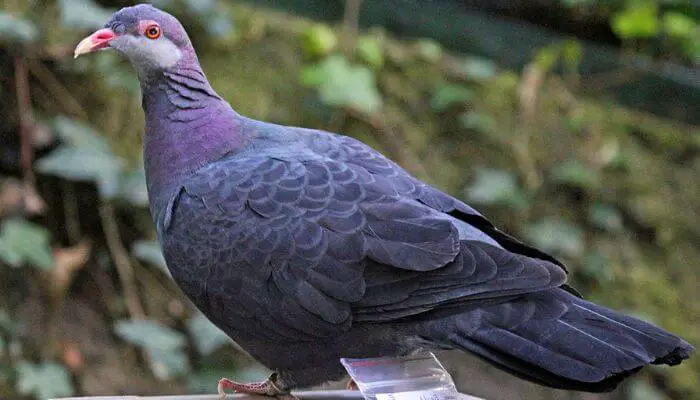The Metallic pigeon (Columba vitiensis) also known as the white-throated pigeon is a medium-sized species with a wide-ranged distribution in Malesia.
Its distinctive triangular throat patch varies in color according to where the bird is found, differing between various islands.
Origins of the Metallic Pigeon
The Metallic Pigeon is a native species of the Columbidae family that has evolved without human intervention.
There are various sub-species (as indicated by their color variants) and these will have been the result of migratory movements as the bird colonized various islands in the region.

The pigeon received its binomial name in 1830 from Quoy (French zoologist) & Gaimard (French naturalist).
Distribution And Habitat of the Metallic Pigeon
The metallic pigeon enjoys a good range in the southwest of the southern hemisphere being found from eastern Indonesia, across the Philippines and Malaysia to the Pacific nations of Timor-Leste, Fiji, Papua New Guinea, the Solomon Islands, Samoa, Vanuatu and New Caledonia.
The Lord Howe pigeon, a subspecies of the metallic pigeon used to exist in Australia. It was only ever found on Lord Howe Island in the Tasman Sea, but it was hunted to extinction in the 1850s.
This was the southernmost extreme of its range. Today, its southern limit is New Caledonia in the Coral Sea.
The metallic pigeon is quite adaptable to different habitats and is found at various altitudes in tropical forests and scrublands and is not unhappy close to human settlements, particularly on the smaller islands.
There is some evidence that the metallic pigeon may make some short migrations between islands but it is not classed as a migratory bird.
It is, however, nomadic in nature and will undertake irregular local movements in search of food.
Red List Status of the Metallic Pigeon
With its stable population and geographic spread, this species is classed as “least concern” on the IUCN Red List.
The metallic pigeon is a protected species in Fiji (as are all native birds) and a partially protected species in Vanuatu where it can only be hunted between April and June.
Appearance of the Metallic Pigeon
| Wingspan | Length | Weight | Coloring | |
|---|---|---|---|---|
| Metallic Pigeon | 13 – 16 cm | 35 – 37 cm | 320 – 360 g | Mainly blue-grey with white throat patch |
| Average Feral Pigeon | 64 – 72 cm | 32 – 37 cm | 300 – 500 g | Bluish grey with some black |
The coloring of the metallic pigeon is quite variable in different locations.
All species share a head and neck of iridescent feathers of purple and green but the main body color depends on the subspecies and may be a dull purplish-chestnut color or a glossy purple-green.
Wings are black and broad as are the upper tail coverts. The tail is fan-shaped.
The bird has purplish feet with large claws, a yellow chisel-shaped bill and eyes with yellow-ish red irises.
It most distinguishing feature is the throat which is much paler than the body and head. The throat patch can range from white to pale creamy-grey.
Both sexes share the same coloring while the younger birds will sport a duller plumage.
Character of the Metallic Pigeon
The Metallic pigeon is happy on the ground and in trees, moving between them to forage for food.
They are not known for being particularly skittish birds, happily living near humans, especially on smaller islands.
It has a few different vocalizations including a deep booming coo and a higher-pitched “COOroo…COOroo…COOroo..”
This species has a life span of 5 – 6 years.
Diet of the Metallic Pigeon
Mostly a frugivorous species, the metallic pigeon will also eat grains, seeds and berries.
Its primary source of food is ficus trees (figs) and these will vary according to geographical location of the bird.
For example, in New Guinea and the Solomon Islands, the metallic pigeon will eat the fruit of the Ficus bernaysii, whereas another food source, the Ficus wassa, is found across Malesia.
Metallic Pigeon Mating And Breeding
Though the Metallic pigeon is thought to breed throughout the year, it is believed that the peak period is the rainy season.
Pairs form and build flimsy nests made from twigs and leaves, and the female will usually lay a clutch of two eggs.
These eggs are incubated by both the male and female for an average of 14 days, and the chicks are then fed crop milk for a period of two weeks before leaving the nest.
Care Of Metallic Pigeons
As the Metallic pigeon is not a species that is generally considered for domestication and breeding, the main care advice for the breed focuses on protecting the natural habitats so that the birds remain able to thrive and flourish.
